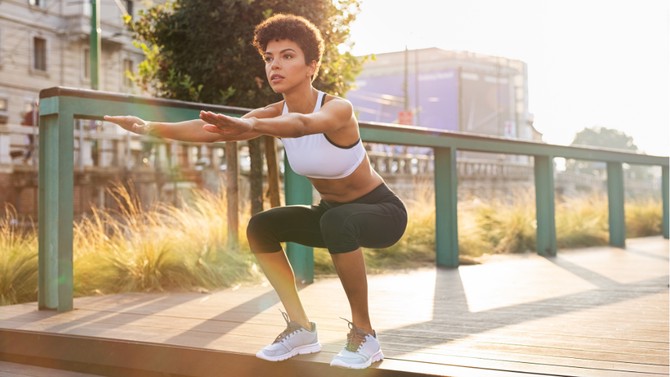4 Exercises Every Woman Should Be Doing by Age 35
Add these expert-recommended moves to your workout for optimal health now—and reap the benefits well beyond.
By Emily Abbate

Photo: Rido/Canva
Deep Squat
Why this: Deep squats, where your hip crease goes past the knees, are not only great for your overall mobility, but they also increase knee stability by building strength in the quads, says Taylor Gainor, co-founder and trainer at LIT Method. And when you consider that knee arthritis affects younger people, too, strengthening and protecting your knees becomes especially important. Researchers estimate that nearly 6.5 million people between the ages of 35 and 84 will be diagnosed with knee osteoarthritis by 2020.
How to do it: Stand with your feet hip-width apart and either arms by your sides or hands clasped in front of your chest. Sit back in your heels, as if you're going to sit in a chair. Lower your body as far as you can, until your thighs are below parallel to the ground. Pause for 1 second, then push through your heels to return to start for 1 rep. Do 3 sets of 10 reps. (For an extra challenge, hold 8-pound dumbbells at your sides, while maintaining proper form.)
Did you know: You don't need to add loads of weight to your squat in order for it to be effective. In fact, a small study found that deep squats done with lighter weights were more effective at increasing strength than parallel squats done with heavy weights.

Photo: Fly View Productions/Getty Images
Dumbbell (or Kettlebell) Deadlift
Why this: You may already know that bone mass and muscle mass tend to decline with age, starting in your 30s. The good news: Weight-bearing exercises can help. "Not only do deadlifts help build strength, but they also increase bone density and release testosterone, a hormone that is responsible for muscle growth and the overall strength of your bones," says Adam Rosante, a celebrity strength and nutrition coach.
How to do it: Stand with your feet hip-width apart, holding dumbbells in front of your thighs, with palms facing in. With a slight bend in the knees, hinge forward at the waist, making sure not to arch your back. Lower the dumbbells over your shins, toward your feet, until you feel a stretch in your hamstrings. Squeeze through your glutes and return to the starting position. This is 1 rep. Do 3 sets of 12 reps.
Did you know: Instead of pulling the weight back up after the lowering phase of your deadlift, think about pressing the floor away, says Rosante. "It'll put emphasis into your glutes and hamstrings, instead of into your back."

Photo: Miodrag Ignjatovic/Getty Images
Resistance-Band Row
Why this: As a large, complex and often overlooked joint, your shoulder is pretty prone to injury. Gainor recommends this exercise, which uses a resistance band, with or without handles, for strengthening your rotator cuff—the group of muscles and tendons that protect your shoulder joint and helps you move your arm over your head. Since rotator cuff injuries are most common between the ages of 40 and 70, the earlier you can start strengthening the shoulders, the better.
How to do it: Stand up straight over the center of a resistance band with your feet hip-width apart. Bend your knees slightly and hinge forward at your waist, sending your hips back. Holding an end of the band in each hand, bend your elbows and row the band up toward your hips, squeezing your shoulder blades together. At the top of the movement, your elbows should form a 90-degree angle. Lower your arms for 1 rep. Complete 3 sets of 12 reps.
Did you know: Resistance bands can add a lot of variety to your workout, since you can gain resistance in all directions—instead of the preset path that standard weight machines offer. The bands also allow you to target smaller muscles more easily.

Photo: voronaman/Canva
Burpee
Why this: High-intensity interval training (HIIT) should be familiar to most gym-goers—and followers of fitness trainers on Instagram—as an effective way to torch fat. Now one more reason to start doing HIIT: The workout may help to reverse signs of aging. In a new study published inCell Metabolism, researchers found that the group participating in high-intensity exercises, such as cycling and fast-walking intervals, yielded the most benefits at the cellular level, with a reversal in age-related cell processes. The classic HIIT move that Rosante recommends adding to your fitness routine: the burpee.
How to do it: Stand with your feet hip-width apart. Lower down into a squat, place your hands on the floor in front of your feet, then kick your legs pack into a plank position. Do one push-up (lower to your knees if you need to). Hop your feet forward to their original position, stand and jump into the air. That's 1 rep. Do as many as you can for 30 seconds, then rest for 30 seconds. Repeat 4 times.
Did you know: According to one small study, performing 10 fast-paced burpees was found to be just as effective at revving up the metabolism as a 30-second all-out sprint.
Published 06/13/2017
As a reminder, always consult your doctor for medical advice and treatment before starting any program.

